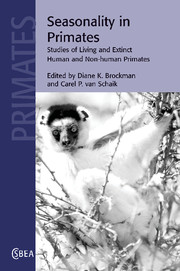Book contents
- Frontmatter
- Contents
- List of contributors
- Preface
- Part I Introduction
- Part II Seasonal habitats
- Part III Seasonality and behavioral ecology
- Part IV Seasonality, reproduction, and social organization
- Part V Seasonality and community ecology
- 15 Seasonality and primate communities
- 16 Primate diversity and environmental seasonality in historical perspective
- Part VI Seasonality and human evolution
- Index
- References
15 - Seasonality and primate communities
Published online by Cambridge University Press: 10 August 2009
- Frontmatter
- Contents
- List of contributors
- Preface
- Part I Introduction
- Part II Seasonal habitats
- Part III Seasonality and behavioral ecology
- Part IV Seasonality, reproduction, and social organization
- Part V Seasonality and community ecology
- 15 Seasonality and primate communities
- 16 Primate diversity and environmental seasonality in historical perspective
- Part VI Seasonality and human evolution
- Index
- References
Summary
Introduction
In this chapter, we examine the extent to which environmental seasonality and, hence, phenological seasonality affect aspects of primate communities. Two aspects of community structure are especially interesting in this context: (i) community composition and, hence, species richness, trophic distribution, and size distribution, and (ii) community biomass. Over the past few decades, there have been several major efforts to identify the factors responsible for the variation in these features of primate communities (Bourlière 1985; Terborgh & van Schaik 1987; Fleagle et al. 1999; Stevenson 2001). Surprisingly, however, few general conclusions have emerged. There may be several reasons for this lack of success, although at this stage we will have to take an empirical approach.
The general question of how seasonality affects communities can be broken down into two parts. First, we can ask what factors affect the presence of a species at any given site and, hence, more broadly, what factors affect the distributional range of a species. This question about the determinants of species richness and geographical patterns in diversity has spawned a large literature (Huston 1994; Rosenzweig 1995). If biogeographic, i.e. historical, factors are kept constant, then there is an approximately linear relationship between productivity, from the perspective of the taxon under consideration, and local species richness or alpha-diversity, at least for animal consumers such as primates (Ganzhorn et al. 1997; Kay et al. 1997).
- Type
- Chapter
- Information
- Seasonality in PrimatesStudies of Living and Extinct Human and Non-Human Primates, pp. 445 - 464Publisher: Cambridge University PressPrint publication year: 2005
References
- 18
- Cited by

